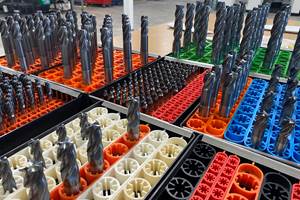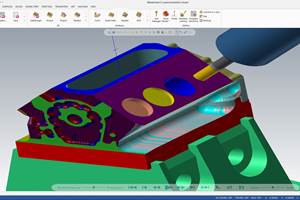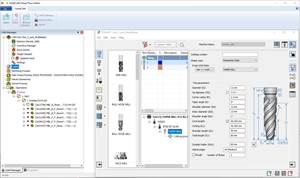Extending CAD/CAM Associativity To Suppliers
Many product manufacturers today are asking for suppliers' help in cutting costs and shortening the product development cycle. These companies know that someone intricately familiar with the machining process can evaluate a product design to minimize manufacturing costs in ways that a designer may not. In return, the supplier benefits from more business, greater profits and a competitive edge.
Many product manufacturers today are asking for suppliers' help in cutting costs and shortening the product development cycle. These companies know that someone intricately familiar with the machining process can evaluate a product design to minimize manufacturing costs in ways that a designer may not. In return, the supplier benefits from more business, greater profits and a competitive edge.
CAD/CAM technology can play a decisive role in this closer supplier-customer relationship. When both parties use the same product data, the cycle from initial product concept to proven, cost-effective manufacturing process is compressed. That's the fundamental concept that CAD/CAM developers such as Parametric Technology Corporation (Waltham, Massachusetts) have had in mind almost from the very start. Says PTC's vice president of technical marketing, Joe Lichtenberg, such systems "have strengthened supplier/OEM partnerships by providing design-through-manufacturing software suites that are fully associative, allowing the supplier and OEM to work on the same data, eliminating the need for translation and cleanup."
Original equipment manufacturers (OEMs) have enjoyed the benefits of full associativity within their organizations for years. As designers continue to develop and iterate on designs, all assemblies, drawings and analysis models update automatically, resulting in substantial savings. Extending full associativity outside the company to the manufacturing supplier allows the OEM and supplier to work on the same electronic product model. Changes made anywhere along the design and production path—for instance, adding draft to a pocket—are immediately reflected in both the design model and the CNC tool paths. Best of all, an associative CAD/CAM suite supports concurrent engineering. Manufacturing can begin creating tool paths before the design is finalized. The art-to-part cycle is compressed.
Even so, says Mr. Lichtenberg, "Many machine shops have not yet made the switch to an associative CAD/CAM suite. One reason may be that although the CAD models are often complex, the production tool paths required to machine the finished part from a billet or casting are often straightforward. Because of this, production machine shops might use CAM software that is easy to use but that has little or no associativity."
To support the case, PTC points to the file translation problems job shops know well. Inaccurate data translation from CAD to CAM software can bring product development to a halt. Because IGES and STEP files were intended as data-neutral file formats, they do not retain the intelligence embedded in the design model, often do not present complex geometry accurately, and do not support concurrency or multiple design iterations. Moreover, the design trend toward creating more complex surfaces creates an even greater reliance on accuracy in translation. For suppliers, translated data means more time lost in repairing files, and additional time and cost to handle changes to the designs.
"Ultimately, the best translation is no translation at all—complete software compatibility," says Mr. Lichtenberg." And that's a big part of the idea behind a new extension to PTC's Pro/NC CAM software called Expert Machinist. "PTC has developed Expert Machinist in order to bring all the benefits of Pro/NC specifically to production shops in a completely new, lightweight, easy to use package," he says.
To operate Expert Machinist, the CNC programmer selects from a set of common manufacturing features, such as profile and pocket, and clicks on the appropriate spot on the CAD model for that machining step. The software is preloaded with standard machining strategies so that production-quality tool paths can be generated with just a few clicks of the mouse. Users can also customize the standard tool paths for each feature type to reflect their own shop's standard practices. This customization can be saved and reused for subsequent part programs.
PTC says that the software is inexpensive and easy to learn and use, plus it provides shops with the benefits of full associativity with the Pro/ENGINEER design model. Thus job shops using Expert Machinist can exchange files directly with customers who use Pro/E without having to take time to repair files or update tool paths after engineering changes.
The argument for extending full associativity to the supplier community will likely grow stronger as product manufacturers continue to seek out ways to reduce costs and further shorten time-to-market cycles. Those companies will press for even shorter turnaround from suppliers, reduced penalties for last-minute design changes, and the ability to work concurrently, allowing the supplier to impact the design for manufacturability. With the right software and a close partnership, an OEM may discover that some of its most valuable people work for its supplier.
Related Content
Grinding Simulation Enables Growth in Custom Tooling
Simulation software both streamlines Gorilla Mill's grinding machine setups and speeds up the company's tooling design and verification processes.
Read MoreCan ChatGPT Create Usable G-Code Programs?
Since its debut in late 2022, ChatGPT has been used in many situations, from writing stories to writing code, including G-code. But is it useful to shops? We asked a CAM expert for his thoughts.
Read MoreCAD/CAM System Requirements: An Overview
CAD/CAM programs are among the most demanding kinds of computer software. Smooth operation requires careful consideration of computer specifications.
Read MoreBuilding A Powerful Bridge from the CAM Programmer to the Shop Floor Operator
SolidCAM for Operators provides a powerful bridge from CAM programming to the shop floor to best streamline the machine shop process with its CAM part simulation. It provides a clear picture to the operator for setup and prove-out, enables minor G-Code changes and avoids crashes, broken tools and scrapped parts.
Read MoreRead Next
3 Mistakes That Cause CNC Programs to Fail
Despite enhancements to manufacturing technology, there are still issues today that can cause programs to fail. These failures can cause lost time, scrapped parts, damaged machines and even injured operators.
Read MoreThe Cut Scene: The Finer Details of Large-Format Machining
Small details and features can have an outsized impact on large parts, such as Barbco’s collapsible utility drill head.
Read More

























